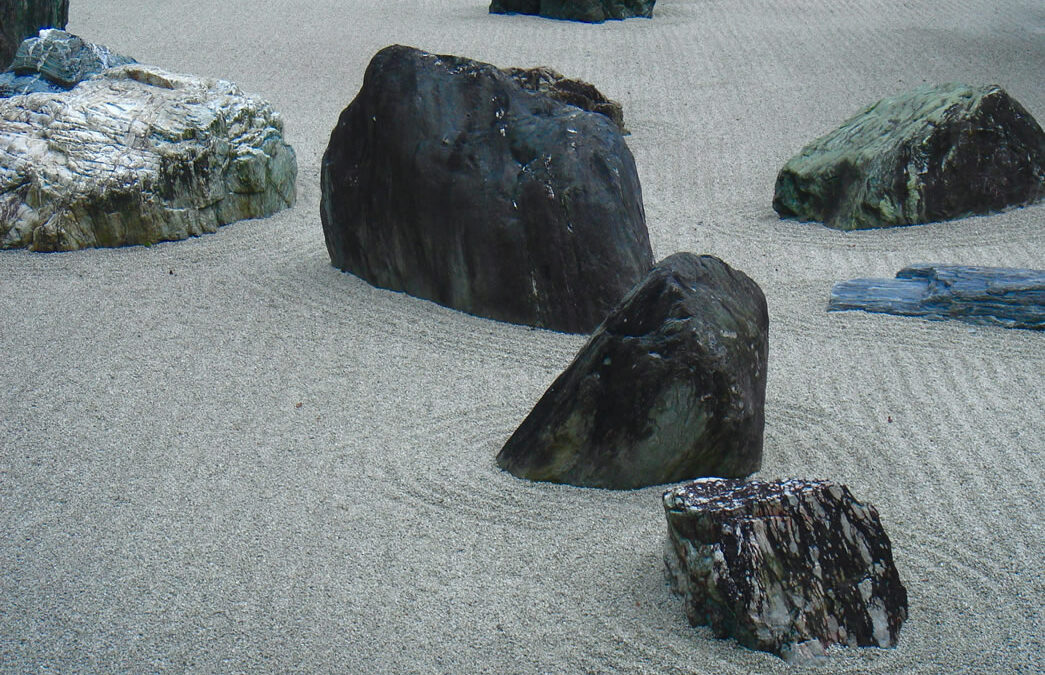Many people turn to gardening as a form of meditation — connecting their hands to the earth and focusing on tending to their plants. In East Asia, the practice of meditative gardening, or Zen gardening, is sacred and is interpreted as a method to connect your body to a higher plane. Here are some Zen garden ideas to help you.
While this practice is mostly done in East Asian nations, people from different cultures can perform it if they respect the culture and tradition behind Zen gardening. If you want to build a Zen Garden on your lawn or are looking for Zen Garden ideas, this guide will help you get started.
What Is a Zen Garden?
Zen gardening is a deeply cultural and philosophical form of garden practice. While most gardens are dotted with lavish colors and flourishing foliage, Zen gardens are not. Zen gardens are unconventional in that they utilize rocks, sand, gravel, moss, and tightly trimmed trees and bushes.
Because of their simplicity, Zen gardens are often called dry gardens. However, modern practices in Zen gardening allow for minimal use of plants, trees, and water. Some may include a small pond, but it’s more of a preference.
Origins of Zen Gardens
Zen gardens have a rich and colorful history in Japan and other East Asian countries. While the rocky Zen garden is often attributed to Japan, the practice actually started in China. During the Song dynasty, the Chinese used stacks of rocks to symbolize Mt. Penglai, a mythological mountain where the eight immortal Chinese deities rest.
The introduction of Zen Buddhism in Japan during the Muromachi period marks the start of the popularity of Zen gardens in the country. Zen Buddhism anchors on the doctrine of self-discipline, and meditation is one of its essential religious practices. The need for a place to practice meditation with nature sprung the first Zen garden in the country, and soon after, every Zen master incorporated this space in their temples.
Characteristics of Zen Gardens
It’s easy to spot a Zen garden when you see one. Traditional Zen gardens are “dry,” meaning they are devoid of plants or water. This minimalistic design is intentional as it prevents the mind from wandering and allows the practitioner (the monk) to center and meditate deeply.
Zen gardens only use gravel or pebbles as the base since the wind easily sweeps sand, and soil would support plant growth. Decorative patterns are also characteristic of Zen gardens. These patterns often depict Mt. Penglai or other Japanese mythologies.
Modern-day Zen gardens sometimes incorporate a Zen pond — a pond enclosed with pebbles — which might be controversial to some practitioners as it steers away from the traditional practice. You could also incorporate bridges, lanterns, and gazebos to suit your preferences.
The Benefits of Zen Gardening
When Zen Buddhism was gaining popularity in ancient Japan, the first group of people who converted to the religion were the samurais and warlords. They admired the inward-looking principle of Zen. This principle is also reflected in the rapid adaptation of Zen gardens, a dedicated place where practitioners can nourish their minds and reinforce their bodies.
Promotes Mindfulness
Zen gardens are traditionally used to meditate and introspect. The minimalistic and monochromatic layout of this garden disarms the mind of disruptive thoughts and makes it easier to center oneself and be more mindful.
Nourishes Creativity
Mindfulness and clarity breed creativity. If you’re looking for a creative boost, starting a Zen garden or visiting one might help your creative wheels turn. Designing Zen garden ideas can also be your canvas to let out your creative energy.
Reinforces Connection to Nature
Zen practitioners believe that Zen gardens can help us ground ourselves and restore our connection with nature. The natural landscape of a Zen garden stimulates a soothing reaction in our bodies. Several studies have already proven the mental and physical benefits of being surrounded by nature.
Improves Focus
Without the usual sensory distractions in traditional gardens, being or meditating in a Zen garden helps improve our focus. Visiting a Zen garden could help if distracting or stressful thoughts pervade your mind.
How To Start a Zen Garden
Starting a Zen garden is a demanding job but not impossible. Here are the some Zen garden ideas and steps involved in starting one.
Indoor vs Outdoor: Choose the Right Location
Like most gardens, a Zen garden is typically placed outdoors, often in the backyard or the lawn. However, you can also dedicate a room or space indoors to install your Zen garden. If you’re not ready to commit financially, physically, and mentally to a full-size Zen garden, you can always start with a mini, box-sized Zen garden.
A great thing about outdoor Zen gardens is that they’re flexible. You can easily execute your idea if you want to change something in the design or expand the space.
The Materials You’ll Need
When planning your Zen garden project, it’s important to use the seven guiding principles to choose the suitable materials for your dry garden:
- Unconventional (Datsuzoku)
- Asymmetry (Fukinsei)
- Simplicity (Kanso)
- Sternness (Koko)
- Stillness (Seijaku)
- Naturalness (Shinzen)
- Allusion (Yugen)
As reiterated throughout this guide, natural elements like gravel and pebbles are essential in every Zen garden, so you can start with that. You can add more elements to suit any of the principles above.
Design the Layout
Go around the space you want to build your Zen garden and visualize how you want it to look. Sketch your design or search for Zen garden ideas to supplement your vision. The more specific you are with your vision, the better the outcome.
Plants To Use for a Zen Garden
Conventional Zen gardens don’t have plants, but you can incorporate your favorite greens to make the place more natural. Moss, bamboo, and traditional Japanese flora are often used to embellish Zen gardens. However, it’s more cost-effective and feasible to use native plants.
Several modern Zen gardens incorporate flowering shrubs or trees, such as cherry blossoms, to give their dry garden a splash of color. If you want something minimal, bonsai trees are also a great addition.
Zen Garden Maintenance
Maintaining a Zen garden also takes work, especially if you decorate your garden with plants. Here are some maintenance practices you should do regularly to keep the exceptional appearance of your Zen garden:
- Pruning and Tree Shaping: If you’re keeping plants in your Zen garden, pruning and shaping them will probably take up most of the maintenance time. You can hire a professional to do this for you, but you can DIY it if you’re up for the challenge.
- Raking: Your next main maintenance task (or primary if you don’t have plants) is raking patterns in your dry garden. You can study traditional rock garden patterns or find some inspiration online.
- Weeding: Keeping your weed population to zero is critical to your Zen garden. You should keep a keen eye on any unwanted green sprouting in your dry garden and yank it out immediately.
- Rock Maintenance: Over time, rock degrades on its own due to weathering. If you notice cracks on your rocks, it’s time to replenish your Zen garden with a fresh supply.
- Seasonal Preparation: Outdoor Zen gardens are susceptible to environmental changes, so prepare your dry garden for the upcoming season.
It might take effort to maintain a Zen garden, but having a sacred place for a restorative respite in your own home is worth it.
Create Your Own Backyard Meditative Oasis
A Zen garden is a perfect addition to any home. Imagine taking a break during a stressful day and heading to your Zen garden to meditate and introspect. So, grab your mower and prepare your lawn for a transformation.
Frequently Asked Questions (FAQs)
What Is the Concept of Zen Garden?
Zen gardens can be traced back to the Muromachi period (1336-1573) when Zen Buddhism was introduced in Japan. Japanese Zen monks incorporated these dry gardens into their temples as a meditation place, an important religious practice in Zen. Fast-forward to today, many homeowners build Zen gardens for similar reasons — a place for contemplation.
What Is the Best Material for a Zen Garden?
Fine gravel and crushed granite are top choices for Zen gardens. Unlike sand, these materials are heavy enough not to be swept by the wind but still light enough to shape. Pebbles are also a good choice to outline the edges of your Zen garden.
What Plants Are Good for Zen Gardens?
Japanese plants are traditionally used in Zen gardens, especially bonsai and cherry blossom trees. However, you can always incorporate local flora to design your Zen garden. Opting for native plants is more practical and feasible since they’re easily available.

